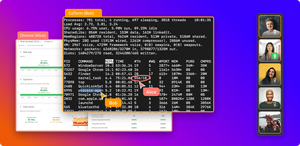Sprints are a popular agile methodology used to organize and manage projects in software development, product development, and other fields. Sprints are time-boxed iterations that usually last between one and four weeks. They are designed to help teams break down complex projects into smaller, more manageable tasks, which can be completed in a focused and efficient manner. In this guide, we will cover the basic steps for organizing sprints and share some best practices to help you make the most of your sprint cycles.
“The important thing is not your process, the important thing is your process for improving your process.”
Henrik Kniberg, @henrikkniberg
Step 1: Define your project goals
The first step in organizing a sprint is to define your project goals. You need to have a clear understanding of what you want to achieve with your project, what features or functionalities you want to deliver, and what problem you want to solve. Your project goals should be specific, measurable, achievable, relevant, and time-bound (SMART). By setting clear and achievable goals, you can keep your team focused and motivated throughout the sprint cycle.
Step 2: Create a product backlog
The next step is to create a product backlog. A product backlog is a prioritized list of features, functionalities, and tasks that need to be completed to achieve your project goals. The product backlog should be created collaboratively with the team and stakeholders, and it should be based on user feedback, market research, and business requirements. The product backlog should be organized in order of priority, with the most important features and functionalities at the top of the list.
Step 3: Plan your sprint
Once you have your product backlog, you can start planning your sprint. Sprint planning is a collaborative process where the team comes together to discuss the goals for the upcoming sprint, review the product backlog, and decide which features and functionalities to work on during the sprint. Sprint planning should be time-boxed and typically lasts between two and four hours for a two- or three-week sprint.
During sprint planning, the team should prioritize the features and functionalities from the product backlog and break them down into smaller, more manageable tasks. The team should estimate the effort required for each task and assign them to team members based on their skills and availability. The team should also identify any potential roadblocks or dependencies that may affect the sprint, and come up with a plan to mitigate them.
Step 4: Conduct the sprint
Once you have planned your sprint, you can start working on the tasks assigned to you. During the sprint, the team should have daily stand-up meetings to discuss progress, identify any roadblocks, and plan the next day's work. The daily stand-up meetings should be time-boxed and typically last between 10 and 15 minutes.
It's important to stay focused during the sprint and avoid distractions. You should try to complete the tasks assigned to you within the time frame allocated. If you encounter any roadblocks or difficulties, you should reach out to your team members for help or guidance.
Step 5: Review and demo
At the end of the sprint, the team should conduct a sprint review and demo. The sprint review is a retrospective meeting where the team reflects on the sprint and discusses what went well, what didn't go well, and what can be improved for the next sprint. The sprint review should be time-boxed and typically lasts between one and two hours.
During the sprint demo, the team should showcase the features and functionalities they have developed during the sprint. The sprint demo is an opportunity for the team to get feedback from stakeholders, users, and customers. The sprint demo should be time-boxed and typically lasts between 30 minutes and one hour.
Step 6: Retrospect and improve
After the sprint review and demo, the team should conduct a retrospective meeting. The retrospective meeting is an opportunity for the team to reflect on the sprint cycle and identify areas for improvement. The retrospective meeting should be time-boxed and typically lasts between one and two hours.
During the retrospective meeting, the team should discuss what worked well during the sprint and what didn't work well. The team should also identify any issues or roadblocks that arose during the sprint and come up with strategies to mitigate them in future sprints. The retrospective meeting should be a safe space for team members to share their thoughts and ideas openly and honestly.
Best practices for organizing sprints
Here are some best practices to help you organize successful sprints:
- Keep the team focused on the project goals: It's important to keep the team aligned on the project goals throughout the sprint cycle. Regularly remind the team of the project goals and the importance of achieving them.
- Involve stakeholders in the process: Involve stakeholders in the sprint planning, review, and demo meetings. This will help ensure that the team is working on the right features and functionalities, and it will also help build buy-in for the project and celebrate successes.
- Use a project management tool: Use a project management tool, such as JIRA, Trello, or Asana, to manage your sprint cycles. These tools can help you keep track of the product backlog, assign tasks to team members, and monitor progress.
- Time-boxing: Time-boxing is a key element of sprint cycles. Use time-boxing to keep the team focused and to ensure that they are completing tasks within the allocated time frames.
- Encourage collaboration: Encourage collaboration among team members during the sprint cycle. Regularly hold stand-up meetings, and encourage team members to work together to complete tasks, for example by using pair programming.
- Embrace agility: Agile methodologies are designed to be flexible and adaptable. Embrace agility, and be willing to adjust your sprint cycles as needed based on feedback, changes in priorities, or other factors.
Common pitfalls during sprint planning
Eeven the most experienced teams can sometimes fall into pitfalls during sprint planning. Here are some of the most common pitfalls to watch out for:
- Overcommitting: One of the most common pitfalls is overcommitting to too many tasks during a sprint. It is important to be realistic about what can be accomplished within the given timeframe and not to take on too much work. Overcommitting can lead to frustration and burnout for team members and may also lead to missed deadlines.
- Lack of clarity: Another common pitfall is a lack of clarity about the goals and objectives of the sprint. It is important to have a clear understanding of what needs to be accomplished and how it will be done before diving into the work.
- Poor communication: Effective communication is essential during sprint planning. Poor communication can lead to misunderstandings, confusion, and missed deadlines. It is important to ensure that everyone on the team is on the same page and understands their role in the sprint.
- Unforeseen obstacles: Despite careful planning, there may be unforeseen obstacles that arise during a sprint. These obstacles may include unexpected delays, technical difficulties, or changes in project requirements. It is important to be flexible and adaptable to deal with these obstacles effectively.
- Lack of focus: Finally, a lack of focus can be a significant pitfall during sprint planning. It is important to stay focused on the goals and objectives of the sprint and not get distracted by other tasks or projects.
In summary, avoiding these common pitfalls can help ensure a successful sprint planning process. By being realistic, communicating effectively, staying focused, and being adaptable, teams can set themselves up for success and achieve their goals.
Conclusion
Sprints are a powerful methodology for organizing and managing projects. By breaking down complex projects into smaller, more manageable tasks, sprints can help teams stay focused, efficient, and productive. To organize successful sprints, it's important to define your project goals, create a product backlog, plan your sprint, conduct the sprint, review and demo, and retrospect and improve. By following these steps and best practices, you can make the most of your sprint cycles and achieve your project goals.





